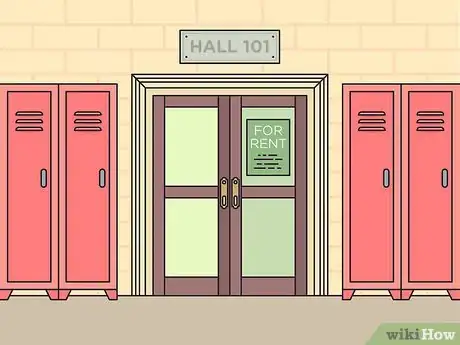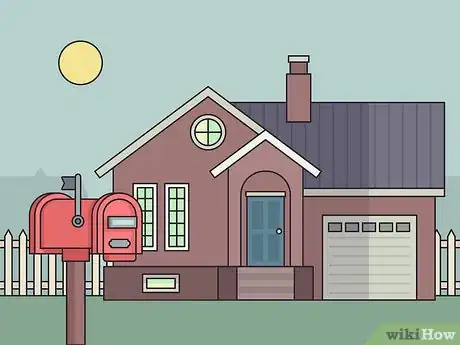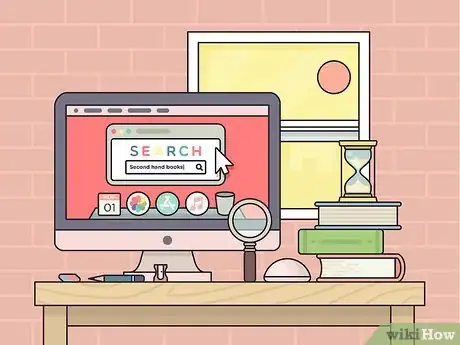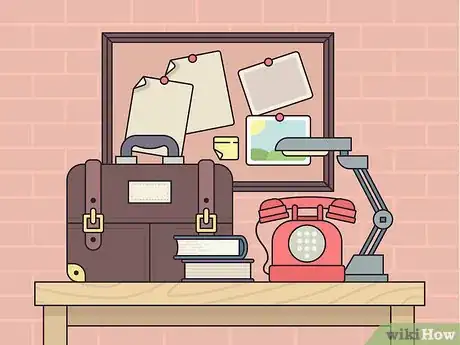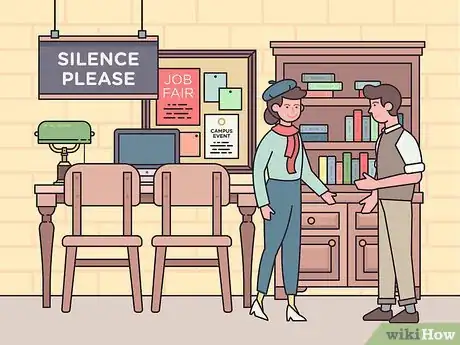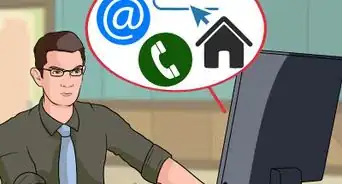This article was co-authored by wikiHow Staff. Our trained team of editors and researchers validate articles for accuracy and comprehensiveness. wikiHow's Content Management Team carefully monitors the work from our editorial staff to ensure that each article is backed by trusted research and meets our high quality standards.
There are 14 references cited in this article, which can be found at the bottom of the page.
wikiHow marks an article as reader-approved once it receives enough positive feedback. This article received 17 testimonials and 84% of readers who voted found it helpful, earning it our reader-approved status.
This article has been viewed 158,223 times.
Learn more...
If you have a passion for reading but don’t have a public library in your neck of the woods, you may be the perfect person to start one. You don’t need any special qualifications to run your own library—all you need is a vision, a collection of books, and a little support from your local community. Start by finding a location that will offer you the space you need to house your books comfortably. You can then begin building your inventory by scouring second hand sources, soliciting community donations, and making deals with popular publishers for new releases.
Steps
Choosing a Location
-
1Rent a building to turn into your own full-functioning library. Look for available properties in your neighborhood that you think might make a good location for a library. Make sure the building you settle on is big enough to meet your spatial demands, including shelves or bookcases for your collection, a checkout desk, study rooms, and any other features you’re envisioning.[1]
- 1,500 sq ft (140 m2) or so should be all you need to house your materials quite comfortably. However, you could operate a modest library with a layout as small as 500 sq ft (46 m2), such as a storefront shop or office space.
- There’s no need to apply for any kind of special license in order to start your own library, unless you plan on providing access to certain types of digital content, such as licensed media, software, and databases. In that case, you may be subjected to fees, subscriptions, and other licensing requirements.[2]
-
2Reserve a room in a communal facility. Talk to the person who runs the facility you’ve got your eye on and see if they have a space where you can establish a library that’s open to visiting community members. This could be a small suite, an unused room, or even a section of a larger room. Be willing to work with what they have to offer, especially if they don’t plan on charging you rent.[3]
- Schools, churches, rec centers, and similar gathering places can all make great locations for a public library.
- If you decide to base your library in a communal building, keep in mind that it may be off-limits during key hours depending on their class, service, or business schedule.
- Seeking space in a busy public facility can draw lots of attention to your library without the need to advertise.
Advertisement -
3Designate a shelf in a local business to serve as a tiny library. Pitch your idea to small business owners in your area who might be interested in hosting an open community library. They may have some spare room that would be perfect for your project. Focus your search on places where avid readers are likely to congregate, like cafés, boutiques, and special interest shops.[4]
- One of the biggest perks of partnering with a local business is that there will always be someone there to keep an eye on things during the day and lock up at night.
- Don’t forget to get permission from the proprietor of the building as well if the business owner is leasing their location.
-
4Set up a book exchange hub if you lack the means to start a larger library. You don’t even need your own room or shelf space to lend out books—all you really need is a place to store them. Simply fill a covered box or cabinet with an array of books and leave it somewhere near your home. Encourage people passing by to pick out a book and leave one of their own in return.[5]
- Situate your book exchange hub outside your home, in the cul-de-sac of your neighborhood, or in another safe, well-lit, sheltered spot.
- It’s even possible to make your book exchange hub part of a larger network of little libraries by registering it with a participating organization.[6]
- Maintaining a book exchange hub may be the way to go if you don’t have the money to rent a physical location, or if you’ve been turned down by the community leaders or business owners you’ve approached.
Building Your Book Selection
-
1Find out what kind of demand there is for certain books in your area. Talk to your friends, relatives, neighbors, classmates, and coworkers about what sorts of books they like to read. Gauging demand will help you tailor your selection to the needs, interests, and tastes of the people who will ultimately be making use of it.[7]
- Think about the people that make up your community. If they’re mostly retirees, you might make room for more large-print books and periodicals. If there are quite a few families, a well-stocked children’s section is likely to be a hit.
- If space allows, you also have the option of carrying a wide variety of genres and titles to ensure that there’s something there for everyone.
-
2Score previously-owned books through second hand sources. Browse used book stores, consignment shops, flea markets, and garage sales for selections that you think would make good additions to your library. This is perhaps the best way to put together the core of your collection, as you’ll pay little to no money for most of the books you find but still have the freedom to be as choosy as you like.[8]
- Online book sellers like Amazon, Better World Books, AbeBooks, and Half.com also typically have extensive selections of used books at low prices.[9]
- Only buy books that are in decent shape, as you can expect them to pick up a little wear and tear once they start changing hands. Pass on titles with torn or faded covers, loose or broken binding, missing pages, water damage, or heavily stained or soiled spots.
-
3Solicit donations from the members of your community. Create a social media account for your library that you can use to spread the word about your need for donations. You could also distribute flyers or rely on good ol’ word-of-mouth campaigning. Provide detailed information about the kinds of books you’re looking for, as well as the general condition they need to be in.[10]
- Hold an on-site book drive event where people can come to unload their old and unwanted books, or start a mobile collection service to go around and pick them up yourself.
- Keep in mind that many of the donations you receive will be things that people are looking to get rid of, which means they may not all be titles that your members are dying to read.[11]
- Post a wishlist of specific books you’re after on your social media page. That way, you’ll be much more likely to actually get the items you want.
-
4Make a deal with publishers to get distribution rights for new releases. Get in touch with the marketing departments of various publishing houses and let them know that you’re starting a library and would like to feature some of their titles. Many companies are happy to negotiate deals to supply library owners with wholesale quantities of books at special discounted prices.[12]
- Most publishing houses provide contact info for marketing and business-related inquiries on their websites.
- Make it clear to the representative you speak to that you don’t intend to sell their books for profit. Otherwise, they may try to charge you a higher distributor rate.
Setting up Your Library
-
1Acquire bookshelves to stock the titles you want to loan out. They don’t need to be fancy—they just need to get the job done. If possible, try to find storage solutions that match or compliment one another in terms of size and style so that your finished library will have a neat, uniform appearance.[13]
- Hunt for matching sets of bookshelves and cases at antique stores and consignment shops.
- You can often find brand-new bookcases at home goods stores for $50-100 apiece. Buying new is a helpful option if you have a little more money to spend, since newer units look better and tend to be more durable.[14]
-
2Come up with a basic system for organizing your collection. For instance, you might start by sorting your collection into broad categories, such as fiction, non-fiction, and reference or textbooks. From there, you can divide them up into more specific genres, like “sci-fi/fantasy,” “biography,” or “true crime.” Once you have your books grouped appropriately, arrange them on each shelf in alphabetical order by author.[15]
- If your goal is to run a library with a big inventory, you’ll probably want to keep a shelf list, or a detailed record of how your books are classified and where to locate them on the shelves.
- Municipal public libraries rely on a complex method of organization known as the Dewey Decimal System to sort their books, but this is really only necessary if you have many hundreds or thousands of books.[16]
- Print labels to go on your shelves. They’ll make the sorting process easier and help direct your visitors to the titles they’re looking for.
-
3Issue library cards and establish a procedure for checking out books. Print your own customizable library cards to give out to anyone who wants to sign up as a member. Be sure to get each new member’s full name, address, and phone number or email when they sign up. For most small libraries, the checkout process will then be as easy as making a note of who has what and when it’s due back.[17]
- Set a cap for the number of books that members can check out at one time, along with minor late fees for titles that aren’t back by their agreed-upon return date.
- Apps like iBookshelf, My Library, and Book Crawler may also be useful for managing large catalogs and mountains of member records.[18]
-
4Consider offering additional amenities if your budget permits it. Use the remaining space in your library to stock materials like audiobooks, DVDs, magazines, newspapers, and similar periodicals. If you really want to go above and beyond, you might even furnish one or more computers and a WiFi connection for those who come to study or don’t have internet access at home.[19]
- You may need a license in order to legally distribute certain types of digital content. Check your local business laws for more information.[20]
- Make sure that the supplementary materials you stock are educational or informative in some way. You don’t want your library to turn into a glorified video store.
Community Q&A
-
QuestionHow can I start a library in my school?
 Community AnswerTalk to the principal about it. Ask him if there is any free space that you can use. Start the project by asking the students if they have any books that they want to donate. The school might donate some money for the books as well. Start an auction for donating money for the things the library needs such as shelves, tables and chairs.
Community AnswerTalk to the principal about it. Ask him if there is any free space that you can use. Start the project by asking the students if they have any books that they want to donate. The school might donate some money for the books as well. Start an auction for donating money for the things the library needs such as shelves, tables and chairs. -
QuestionI have about 50 books in a small community. How can I keep track of the books going in and out?
 Community Answer50 books is not a large number, so it should be easy to manage. You can start by assigning a number to each book and maintain a register with columns: "Book Number, Borrower, Date Borrowed, and Date Returned." If there is a small group of borrowers, you may just use their names or initials, or if you wish to start a bigger library, then you should register each user assigning them numbers. Maintain a separate register with user details like name, phone numbers, address, date of birth, etc.
Community Answer50 books is not a large number, so it should be easy to manage. You can start by assigning a number to each book and maintain a register with columns: "Book Number, Borrower, Date Borrowed, and Date Returned." If there is a small group of borrowers, you may just use their names or initials, or if you wish to start a bigger library, then you should register each user assigning them numbers. Maintain a separate register with user details like name, phone numbers, address, date of birth, etc. -
QuestionI want to open a free library at my home. How do I organize that?
 Community AnswerThe article has some useful suggestions. You could also start a free book library out the front of your house in an old fridge or sheltered box, with a sign that people can take and share whatever they like. Beware though, people will take anything if it's free, so you need to keep restocking it often.
Community AnswerThe article has some useful suggestions. You could also start a free book library out the front of your house in an old fridge or sheltered box, with a sign that people can take and share whatever they like. Beware though, people will take anything if it's free, so you need to keep restocking it often.
References
- ↑ https://bizfluent.com/how-5079698-start-small-library.html
- ↑ http://www.ala.org/aboutala/sites/ala.org.aboutala/files/content/publishing/editions/samplers/harris_licdigcon.pdf
- ↑ https://files.eric.ed.gov/fulltext/ED536916.pdf
- ↑ https://files.eric.ed.gov/fulltext/ED536916.pdf
- ↑ https://livability.com/topics/community/6-tips-to-start-a-little-free-library-in-your-neighborhood
- ↑ https://littlefreelibrary.org/
- ↑ https://files.eric.ed.gov/fulltext/ED536916.pdf
- ↑ https://www.weareteachers.com/15-free-or-cheap-ways-to-stock-your-classroom-library/
- ↑ https://moneypantry.com/cheap-books/
- ↑ https://libguides.ala.org/book-donations
- ↑ http://www.ala.org/tools/starting-library
- ↑ https://bizfluent.com/how-5079698-start-small-library.html
- ↑ https://bookriot.com/2018/03/09/home-library-bookcases/
- ↑ http://nymag.com/strategist/article/best-cheap-bookcases.html
- ↑ https://files.eric.ed.gov/fulltext/ED536916.pdf
- ↑ https://www.oclc.org/content/dam/oclc/dewey/resources/summaries/deweysummaries.pdf
- ↑ https://bizfluent.com/how-4517199-start-church-bookstore.html
- ↑ https://www.insidehighered.com/blogs/gradhacker/7-apps-cataloguing-your-home-library
- ↑ https://files.eric.ed.gov/fulltext/ED536916.pdf
- ↑ http://www.ala.org/aboutala/sites/ala.org.aboutala/files/content/publishing/editions/samplers/harris_licdigcon.pdf

